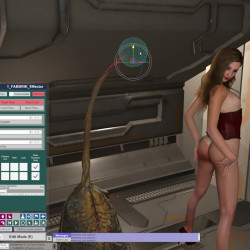Hi, sorry I'm a bit new to vamhub so didn't know there was a discussion thread here till I clicked on it.
This is a bit of a long set of questions but I'll do what I can to explain.
I do not understand anything what this Plugin is offering.....
Broadly what this plugin allows you to do is add non-native VAM creations into VAM and then move them around in a somewhat natural way. For example you could add a crab and move the legs so it looks like it was part of VAM or a squid monster if that was more your thing. None of those things are natively in VAM but can be added and animated to interact with your VAM scene and people.
1) Load in a rigged custom unity asset
> What is a rigged Asset ?
How do i know i load a rigged asset ?
And what type would that be usually?
Pretty much all objects within game engines are composed of transforms, a transform is something that exists at a given position in space(think x,y,z coords), has a rotation and a scale. Sometimes these transforms can have meshes(think of a set of points creating a 3d structure) attached to them. A rigged object is something where the transforms within the object are set to change the shape of a mesh. For example a rigged arm might have 3-4 transforms within it that change the shape of the arm as you move the transforms. Sometimes these rigged transforms are called bones, for reasons that are hopefully obvious given my last example.
You don't know something is rigged unless you imported it from unity yourself. Otherwise you have to guess, but you can see the list of transforms on an asset once you load it into the plugin. Often character models are rigged or things that usually move. So a room for example is often not rigged, but a person or say a rope might well be rigged.
2) Add plugin to the CUA
- What is that and how to do that ?
A CUA is a custom unity asset, its a type of VAM atom that lets you load in non-native VAM game objects. If you go into custom/assets within your vam directory you'll find some files called assetbundles that contain these objects.
3) Pick a IK type to configure and add it.
- I do not understand this step either and for what would this be good?
IK stands for inverse kinematics, you can read more about it here:
https://en.wikipedia.org/wiki/Inverse_kinematics
but broadly it means to move the different transforms within a rigged object in a way that seems natural. The IK types I've added support for are:
1) CCD - cyclic coordinate descent, this is kind of like a robot arm movement.
2) FABBRIK - Forward And Backward Reaching Inverse Kinematics. Similar to CCD but uses a less rotation so you end up with less overlapping bits.
3) LimbIK - exactly what it says on the tin, its a simple way of animating an arm, leg or some other limb.
4) FullbodyIK - If you have a person/humanoid you want to animate this is the one. it covers 4 limbs + a head and spine.
If you want to know more about the details of the IK package I used lots to read here:
http://www.root-motion.com/finalikdox/html/index.html. There are more IK solvers in the package that I've not exposed but i can if people want them.
4) pick bones to be moved and hit add
- I do not understand this step either.
What would happen if i would add this ?
As i mentioned earlier you end up with a an game object that has a bunch of transforms/bones. The different IK options use them in a different ways. CCD/FAB will go down a hierarchy and add the bones listed. For Limb you have to tell it exactly which bones to use (often they will be labelled as forearm or ankle as a hint). If you want to see one that is already setup have a look at the anal beads subscene i posted the other day.





